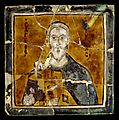Byzantine art facts for kids
Byzantine art is a special kind of Christian art. It was made in the Eastern Roman Empire, which we call the Byzantine Empire. This art style lasted from about the 5th century until the city of Constantinople fell in 1453.
This art style also spread to other countries. These included places like Bulgaria, Serbia, and Rus' (which is now parts of Russia and Ukraine). Even some parts of Italy, like Venice and Sicily, used Byzantine art styles. Art made by Christians in the Ottoman Empire after 1453 is often called "post-Byzantine." Some traditions, like icon painting and church building, are still used today in Greece, Russia, and other Eastern Orthodox countries.
Contents
What is Byzantine Art?
Byzantine art is the art of the Byzantine Empire. This empire was the eastern part of the old Roman Empire. It had its capital city in Constantinople (now Istanbul, Turkey). The art was mostly Christian and religious. It showed stories from the Bible and images of saints.
Why is it Called Byzantine?
The name "Byzantine" comes from Byzantium. This was the original name of Constantinople. The empire was very powerful for over 1,000 years. Its art style was very important during the Middle Ages.
Where was Byzantine Art Found?
Byzantine art was not just in the empire itself. It also influenced many nearby countries.
Countries with Byzantine Art
- Eastern Europe: Countries like Bulgaria and Serbia adopted Byzantine styles.
- Rus': This area, which became modern Russia, also used Byzantine art.
- Parts of Italy: Cities like Ravenna and Venice in Italy show strong Byzantine influences. This was even though they were part of Western Europe.
Post-Byzantine Art
After the Byzantine Empire ended in 1453, the art style continued. Christians living under the Ottoman Empire kept making art in this way. This later art is called "post-Byzantine."
What Kind of Art Did They Make?
Byzantine artists created many types of art. They are famous for their icons, mosaics, and church buildings.
Icons
Icons are religious paintings. They usually show Jesus, Mary, or saints. Icons were very important in Byzantine churches and homes. People used them for prayer and worship. They were often painted on wooden panels.
Mosaics
Mosaics are pictures made from small pieces of colored stone or glass. Byzantine churches were often decorated with amazing mosaics. These mosaics covered walls and ceilings. They showed bright, detailed scenes from the Bible.
Church Architecture
Byzantine churches have a special look. They often have large domes and a central plan. The inside of the churches was usually covered with mosaics or frescoes (wall paintings). These decorations helped tell religious stories to people.
Famous Examples
- Hagia Sophia: This famous church in Constantinople (now Istanbul) is a great example. It has huge domes and beautiful mosaics.
- San Vitale in Ravenna: This church in Italy is known for its stunning mosaics. They show emperors and religious figures.
Other Art Forms
Byzantine artists also made other things. These included:
- Manuscripts: Books with beautiful handwritten text and illustrations.
- Ivory carvings: Detailed carvings made from elephant tusks.
- Metalwork: Objects made from gold, silver, and other metals.
Related pages
Images for kids
-
Icon of the enthroned Virgin and Child with saints and angels, 6th century, Saint Catherine's Monastery, Sinai
-
The Arab Saint Arethas depicted in traditional Byzantine style (10th century)
-
Interior of the Rotunda of St. George, Thessaloniki, with remnants of the mosaics
-
The St. George Rotunda in Sofia, built in the 4th century, and some remains of Serdica can be seen in the foreground
-
Archangel ivory of the early 6th century from Constantinople
-
Mosaic from the church of Hagios Demetrios in Thessaloniki, late 7th or early 8th century, showing St. Demetrios with the bishop and the eparch
-
Helios in his chariot, surrounded by symbols of the months and of the zodiac. From Vat. Gr. 1291, the "Handy Tables" of Ptolemy, produced during the reign of Constantine V
-
An example of Macedonian-era ivorywork from Constantinople: the Forty Martyrs of Sebaste, now in the Bode Museum, Berlin
-
St Mark's Basilica in Venice, where imported Byzantine mosaicists were succeeded by Italians they had trained
-
Modern Orthodox mural from Israel using a depiction of the Nativity of Christ little changed in over a millennium
-
Interior view with the frescoes dating back to 1259, Boyana Church in Sofia, UNESCO World Heritage List landmark.
-
With images of Cupids (10th century), Walters Art Museum
See also
 In Spanish: Arte bizantino para niños
In Spanish: Arte bizantino para niños
























